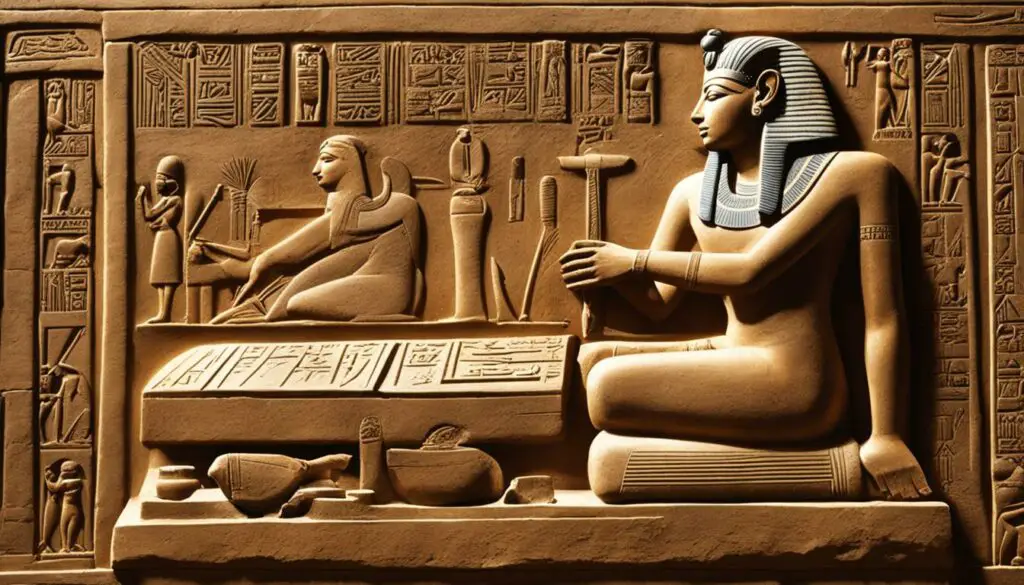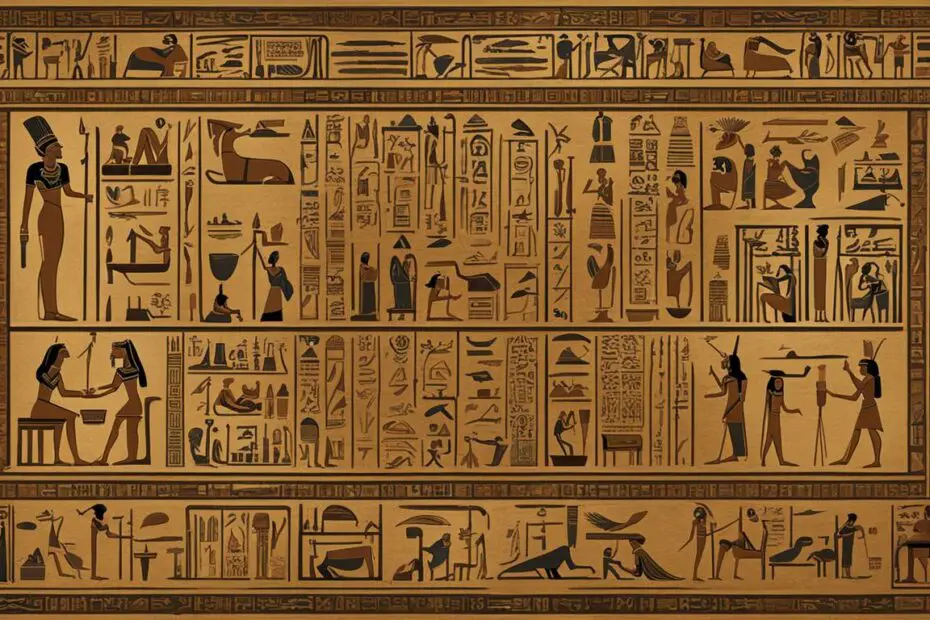Scribes in ancient Egypt played a crucial role in society, serving as writers, record keepers, and administrators. They were highly educated and trained to read and write hieroglyphics, the writing system of ancient Egypt. Scribes were responsible for various tasks, including keeping track of detailed records, creating legal documents, and working in temples. They held an important position in the social hierarchy and were exempt from taxes, military service, and manual labor. The role of scribes was essential to maintaining an efficient government and preserving the history and culture of ancient Egypt.
Education and Training of Scribes
Becoming a scribe in ancient Egypt required years of rigorous education and training. Scribes attended special scribal schools, often affiliated with temples or royal institutions, where they learned to read and write in hieroglyphics, hieratic, and sometimes demotic scripts. Mastery of these writing systems allowed scribes to handle different types of texts and documents.
Education played a pivotal role in the social mobility of individuals, and those who became scribes belonged to the educated elite of ancient Egyptian society. These schools provided comprehensive training in writing, grammar, and various subjects, including mathematics and astronomy.
The rigorous educational process involved memorization and practice, as scribes diligently copied texts and learned the intricacies of hieroglyphic composition. While learning to read and write in hieroglyphics was central to their training, scribes also studied administrative and legal practices to fulfill their roles as record keepers and administrators. They were taught to handle different types of materials, such as papyrus and stone, and were trained in calligraphy to create visually striking inscriptions.
The Importance of Scribes in Ancient Egypt
The scribes held a position of utmost importance in ancient Egyptian society. They were highly respected and cherished for their ability to read and write, which were considered essential skills for maintaining a well-functioning government and society.
Their knowledge of hieroglyphics allowed them to document religious rituals, record historical events, compose royal decrees, and manage administrative tasks. Ancient Egyptian hieroglyphs were a complex writing system comprising vivid pictorial symbols that conveyed sounds, words, and ideas. Scribes played a vital role in preserving the cultural and historical heritage of ancient Egypt through their mastery of this intricate writing system.
Moreover, the education and training of scribes exemplified the importance of social mobility through education in ancient Egypt. Only those who demonstrated exceptional aptitude and dedication were able to embark on the path of becoming a scribe, thereby gaining access to influential roles and privileges within society.
Role and Duties of Scribes
The role and duties of scribes in ancient Egypt were diverse and crucial to the functioning of the society. Scribes specialized in various fields and worked in different contexts, including courts, temples, and government offices. Their meticulous record-keeping and administrative skills were indispensable for the effective operation of the ancient Egyptian bureaucracy.
Court Scribes
Court scribes were responsible for recording royal decrees and administrative matters for the pharaoh. They transcribed important documents, maintained official records, and ensured accurate documentation of legal proceedings. These scribes played a pivotal role in facilitating communication between the pharaoh and his administration, ensuring the smooth functioning of the judicial system.
Temple Scribes
Temple scribes were entrusted with the important task of transcribing sacred texts and maintaining religious records. They meticulously copied religious texts onto papyrus or temple walls, preserving the knowledge and rituals of ancient Egyptian religion. These scribes played a vital role in the preservation and transmission of religious teachings and practices.
Government Scribes
Scribes employed in government offices handled a wide range of tasks related to taxation, legal matters, and trade records. They maintained accurate records of tax collections, managed the distribution of resources, and ensured fair trade practices. These scribes were instrumental in maintaining order and efficiency within the government and supporting economic activities.
Overall, the role and duties of scribes in ancient Egypt were diverse and integral to the functioning of the society. Their specialized skills in record-keeping, transcription, and administration played a vital role in preserving historical records, facilitating governance, and preserving the cultural heritage of ancient Egypt.
The Art of Hieroglyphics
Hieroglyphics, the writing system of ancient Egypt, played a central role in the work of scribes. Hieroglyphics used pictorial symbols to represent sounds, words, and ideas. Scribes skillfully carved or painted hieroglyphics on various surfaces like temple walls, monuments, and papyri. The art of writing in hieroglyphics allowed scribes to convey religious texts, historical records, and literature. Their expertise in hieroglyphics was instrumental in preserving the cultural and historical heritage of ancient Egypt.

Engraving or painting elaborate hieroglyphics was a meticulous craft that required precision and artistic flair. Scribes carefully etched the intricate symbols using sharp tools, ensuring the readability and durability of the inscriptions. The hieroglyphic system encompassed a vast array of characters, including animals, plants, abstract shapes, and human figures, each representing a specific sound or concept.
The hieroglyphic script served multiple purposes in ancient Egyptian society. It was used for religious rituals, where the scribes’ writings played a vital role in conveying divine messages and documenting religious ceremonies. Hieroglyphics were also employed in historical inscriptions, chronicling the exploits of pharaohs and memorializing significant events.
Moreover, hieroglyphics served as a means of communication for the general population. Scribes would write letters, legal documents, and even love poems using the hieroglyphic system. The versatility of hieroglyphics enabled the scribes to express ideas and emotions with remarkable clarity and depth.
The widespread adoption of hieroglyphics across various mediums demonstrates its significance and influence in ancient Egyptian culture. The intricate and visually captivating nature of hieroglyphics not only preserved the ancient Egyptian language but also contributed to the artistic expression of the civilization.
Ancient Egyptian Hieroglyphics Example:
| English | Hieroglyph | Pronunciation |
|---|---|---|
| Sun | Aten | |
| Water |  |
Nu |
| Pharaoh | Nesut |
The table provides a glimpse of the hieroglyphic script and its corresponding English translations. These examples showcase how hieroglyphics were used to encode various concepts and entities in ancient Egyptian society.
Legacy of Scribes
The role of scribes in ancient Egypt left a lasting legacy, with their contributions spanning from preserving knowledge to documenting history and shaping religious practices. These skilled individuals were responsible for meticulous record-keeping, dedicating their lives to the art of writing and providing modern scholars with invaluable insights into the beliefs, customs, and daily life of the ancient Egyptians.
Their involvement in the administrative and bureaucratic systems of ancient Egypt, known for its complexity and organization, underscores the significance of scribes in maintaining order and efficiency in the society. As key members of the bureaucratic apparatus, scribes handled a myriad of tasks including taxation, legal matters, and trade records. Their contributions were pivotal in the smooth functioning of the ancient Egyptian bureaucracy.
Furthermore, the work of scribes played an essential role in the continuity of religious practices in ancient Egypt. As temple scribes, they transcribed sacred texts and were entrusted with preserving religious records, ensuring the continuity and accuracy of religious rituals and beliefs over generations. The meticulousness and expertise of scribes in their craft had a profound impact on the preservation of cultural and historical heritage.
FAQ
What were the roles and duties of scribes in ancient Egypt?
Scribes in ancient Egypt served as writers, record keepers, and administrators. They were responsible for tasks such as keeping detailed records, creating legal documents, and working in temples.
How did one become a scribe in ancient Egypt?
Becoming a scribe in ancient Egypt required years of rigorous education and training. Scribes attended special scribal schools, where they learned to read and write in hieroglyphics, hieratic, and sometimes demotic scripts.
What was the importance of hieroglyphics in the work of scribes?
Hieroglyphics, the writing system of ancient Egypt, played a central role in the work of scribes. They skillfully carved or painted hieroglyphics on various surfaces and used them to convey religious texts, historical records, and literature.
What was the role of scribes in the ancient Egyptian bureaucracy?
Scribes held an important position in the ancient Egyptian bureaucracy. They were employed in government offices and were responsible for tasks such as handling taxation, legal matters, and trade records.
What is the legacy of scribes in ancient Egypt?
The work of scribes in ancient Egypt has left an enduring mark on human civilization. Their meticulous record-keeping and dedication to the art of writing have provided valuable insights into ancient Egyptian culture, history, and religious practices.
